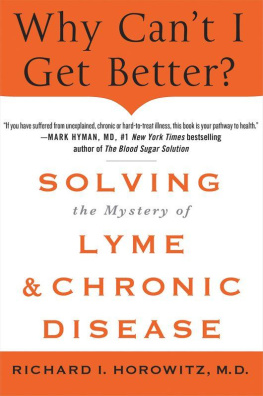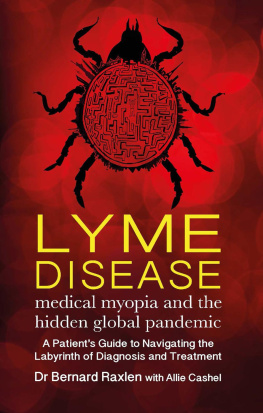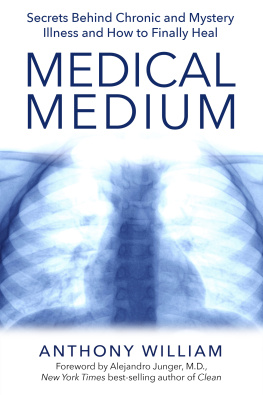
The author and publisher have provided this e-book to you for your personal use only. You may not make this e-book publicly available in any way. Copyright infringement is against the law. If you believe the copy of this e-book you are reading infringes on the authors copyright, please notify the publisher at: us.macmillanusa.com/piracy.
To my mother,
EVELYN LOMBARDI,
and my grandparents,
HELEN and SID GORDON,
for their unconditional love and support.
Acknowledgments
This book represents my lifes work, but it couldnt have been written without the help of many people. Jennifer Weis at St. Martins Press has been an invaluable supporter for many years, and Im thrilled that I was able to work with her. My good friend, science writer Pam Weintraub, has given me skillful guidance, and Pam Liflander has been helpful in getting my thoughts onto these pages clearly and coherently. I am especially thankful for the expert assistance of Professor Phyllis R. Freeman, PhD, of the State University of New York, New Paltz, who served not only as the preliminary editor but also as the subject matter expert on the biobehavioral aspects of chronic infectious disease diagnosis and management. Dr. Freeman has been a longtime friend, and she encouraged me years ago to write this book. Without her constant support and assistance, this book would not have been possible.
A huge thanks goes out to my wife, Lee, for her understanding and support, as long hours (including on vacation) were needed to get this book into its present form. Her love has graced my life.
My office staff also deserves a special thank you for their dedication, hard work, skill, knowledge, and compassion that has allowed me to help so many stricken with chronic illness. These people include: Gina Edwards; John Fallon, NP; Lisa Haynes; Irene Kaminskaya; Casie Luther; Andrea Mahoney, RN; Jennifer Mastroeni, RN; Kalah Matthews, RN; Christina Novak; Monica Pemberton, MA; Sonja Sideras, LPN; Etheldria Walker, MA; William Winters, MA; and Lauren Yunker, PA. I would also like to acknowledge Dr. Leo Galland and Dr. Chris Melitis, from the Integrative Health Symposium conference in New York City, who contributed material, as well as Dr. Eva Sapi, from the University of New Haven, who shared her original research on biofilms. A debt of gratitude also goes out to Dr. Alan McDonald for his groundbreaking work on Borrelia and permission to reprint his slides on its cystic forms, as well as Dr. Judith Miklossy, who provided photos of the atypical and cystic forms of Borrelia in neurological Lyme disease. I also wish to thank Dr. Garth Nicolson for reviewing the initial manuscript and for his assistance in providing extensive scientific literature on mycoplasmal infections and mitochondrial dysfunction. And I would like to recognize the heroes of Lyme disease, who have consistently put their patients before themselves, sometimes at the risk of their own careers. This includes Dr. Joseph Burrascano (who also provided a short history of Lyme disease for this book, and information on Advanced Labs and the new Lyme culture); Dr. Sam Donta; Dr. Charles Ray Jones; Dr. Kenneth Leigner; and many others. Dr. Claire Riendeau provided her insight on biotoxin illness.
I am also grateful for the assistance of several colleagues who lent their expertise and reviewed individual chapters: Allan Warshowsky, MD, for his work on the endocrinology chapter; David H. Haase, MD, for reviewing the GI autonomic nervous system dysfunction, and allergy chapters; Andrea Gaito, MD, for her help with the immunity and inflammation chapters; Sunil Khurana, MD, for helping with the GI and liver function chapters; Fred Harvey, MD, for his assistance in reviewing the chapter on environmental medicine; and David Perlmutter, MD, FACN, who reviewed the brain and pain chapters. Dr. Elizabeth Maloney and Dr. Bea Szantyr also provided their feedback on the manuscript, and I am grateful for their help.
A huge debt of gratitude goes to my spiritual teachers, especially Lama Norlha Rinpoche, who has guided and supported me perfectly through this life.
Finally, thanks to all of the Lyme-MSIDS sufferers, who have been some of the greatest teachers to me in this lifetime. Your courage and perseverance to regain health has inspired me to constantly look for answers, and has been the inspiration for this book.
Contents
Foreword
and when the physicians hand on the patients shoulder or arm is a shelter against the darkness.
NORMAN COUSINS , The Healing Heart: Antidotes to Panic and Helplessness
More than twenty-two years ago I struggled with debilitating pain and unending insomnia, symptoms that left me barely able to work or to deal competently with daily life. I saw specialists in internal medicine, orthopedics, ophthalmology, psychiatry, and neurology but still had no definitive diagnosis for my frightening symptoms. My neurologist said that he had heard of a new internist who was gaining attention as a brilliant diagnostician. I made an appointment for a consultation. What did I have to lose?
I vividly remember my first visit with this physician. Dr. Richard Horowitz sat next to me in the exam room. He read the copious laboratory test results I had brought with me, but then he gently asked me to tell him the story of my illness. He listened intently, taking detailed notes, and urged me to slow down, so that I wouldnt feel rushed to get everything out all at once. When I finished he placed his hand on my shoulder and said, Everything will be OK. That simple act of compassion in response to my narrative was so powerful! For the first time in more than a year I felt that I might regain my former joy and energy; I felt hopeful that I might find a way through the pain and recover my health.
This is a book about diagnosing and treating Lyme and other tick-borne infections. But it is also a book about hope. Hope is a central human emotion, misunderstood and often mistaken for optimism, as Jerome Groopman reminds us in The Anatomy of Hope . Having true hope, he contends, is not about holding a rosy and unrealistic prospect for the future. It is not: Just think positive. Rather, hope is clear-eyed. True hope is seeing a viable route out of the darkness while acknowledging the obstacles that might impede your journey.
This book can provide you with a path through the complicated maze of multiple systemic disease diagnosis and management. If you are a health-care provider, this book can remind you of the vital importance of evoking hope in your patients as you face the relentlessly demanding and endlessly challenging practice of twenty-first-century medicine. If you are a multiple systemic disease patient, this book can be the hand on your shoulder that helps you recover true hope and points you toward a passageway out of your suffering.
Phyllis R. Freeman, PhD
New Paltz, New York
December 2012
Introduction
Exchange yourself with the person you are with. Always think of what would make them happy and what would relieve their suffering. Show loving-kindness and compassion. If you do this, everything will go well.
LAMA GENDUN RINPOCHE
This book is my story as a medical detective who set out to understand the hidden truth behind chronic illness and its relation to Lyme disease. In my quest I have combined the facts of medical science with thousands of clues Ive come across, mostly from listening hard to my patients stories, reading closely in the chronic disease literature, and trusting deeply in my medical intuition. This led me to uncover surprising clues to solve this challenging medical puzzle.
Like many other physicians, my initial understanding was that Lyme disease is caused by a tick-borne spirochetal bacteria, Borrelia burgdorferi , which can progress from a characteristic expanding skin rash, erythema migrans (EM), to a wide variety of nonspecific systemic symptoms that can affect any part of the body. Appropriate and early antibiotic treatment can successfully treat many with the infection. However, in some people a tick bite can lead to disseminated infection and to disabling physical, cognitive, and psychological manifestations. And some people manifest with puzzling multiple systemic symptoms that can occur throughout the body, which lead to complex lab results. Because of this, Lyme disease has been ignored or trivialized by the medical profession for more than a quarter of a century. Many of my patients have seen fifteen to twenty physicians before they walk through the doors of my office, searching for answers for their treatment-resistant symptoms. Their suffering is made worse as they repeatedly face difficulty in obtaining appropriate care from often skeptical medical and insurance communities, as they unknowingly enter one of the most virulent wars between two medical camps that we have seen in our countrys history. One camp, the Infectious Diseases Society of America (IDSA), believes that Lyme disease is an easily diagnosable and treatable condition. The other camp, the International Lyme and Associated Diseases Society (ILADS), believes that the blood tests to diagnose Lyme disease are highly unreliable and that thirty days of antibiotics is often insufficient. Chronically ill patients therefore often go from doctor to doctor searching for answers.
Next page






